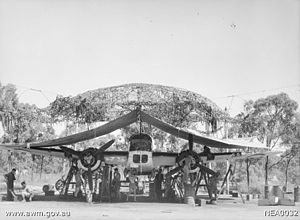- No. 7 Squadron RAAF
-
No. 7 Squadron RAAF 
A No. 7 Squadron Beaufort being serviced at Ross RiverActive 1917–1919
1940–1945Country  Australia
AustraliaBranch  Royal Australian Air Force
Royal Australian Air ForceEngagements World War I
World War IICommanders Notable
commandersJohn Balmer (1942) No. 7 Squadron was a Royal Australian Air Force flying training squadron of World War I and medium bomber squadron of World War II. The Squadron was first formed in October 1917 and was disbanded in December 1945 after seeing action during the Pacific War.
Contents
History
No. 7 Squadron was first formed as a flying training squadron of the Australian Flying Corps at Yatesbury, England on 24 October 1917. Equipped with a wide range of aircraft, the Squadron commenced flying training operations in February 1918 and was tasked to provide replacement aircrew to No. 3 Squadron until being disbanded in early 1919.
No. 7 Squadron was reformed at RAAF Base Laverton on 27 June 1940. While it was intended to equip the Squadron with Lockheed Hudson aircraft, the unit was reduced to cadre status. The Squadron was reformed in January 1942 as a Hudson operational training unit responsible for preparing aircrew for posting to other squadrons. In August 1942, the squadron moved to Nowra, New South Wales where it was reequipped with DAP Beaufort medium bombers and began training to operate in the bomber-reconnaissance role. The Squadron completed its training in October and moved to Ross River near Townsville where it undertook convoy escort patrols over Australia's northern waters. The Squadron was based at Horn Island from April–October 1944, when it moved to Tadji in New Guinea. From November 1944 until the end of the war, the Squadron flew strike missions against Japanese positions in New Guinea. No. 7 Squadron was disbanded at Tadji on 19 December 1945.
Aircraft operated
- Airco DH.6 (October 1917–1918)
- Royal Aircraft Factory R.E.8 (October 1917–1918)
- Royal Aircraft Factory B.E.2 (October 1917–1919)
- Avro 504 (February 1918–1919)
- Bristol Fighter (February 1918–1919)
- Lockheed Hudson (January 1940 – August 1942)
- DAP Beaufort (August 1942 – December 1945)
References
- Steve Eather (1995) Flying Squadrons of the Australian Defence Force. Aerospace Publications.
External links
Main series 1 · 2 · 3 · 4 · 5 · 6 · 7 · 8 · 9 · 10 · 11 · 12 · 13 · 14 · 15 · 20 · 21 · 22 · 23 · 24 · 25 · 26 · 27 · 28 · 29 · 30 · 31 · 32 · 33 · 34 · 35 · 36 · 37 · 38 · 40 · 41 · 42 · 43 · 60 · 66 · 67 · 71 · 73 · 75 · 76 · 77 · 78 · 79 · 80 · 82 · 83 · 84 · 85 · 86 · 87 · 92 · 93 · 94 · 99 · 100 · 102 · 107 · 292 · Fighter · Rescue and Communication · Seaplane · Berlin Air Lift
Article XV squadrons Joint Netherlands-Australian squadrons Categories:- RAAF squadrons
- Military units and formations established in 1917
- Military units and formations disestablished in 1945
Wikimedia Foundation. 2010.
